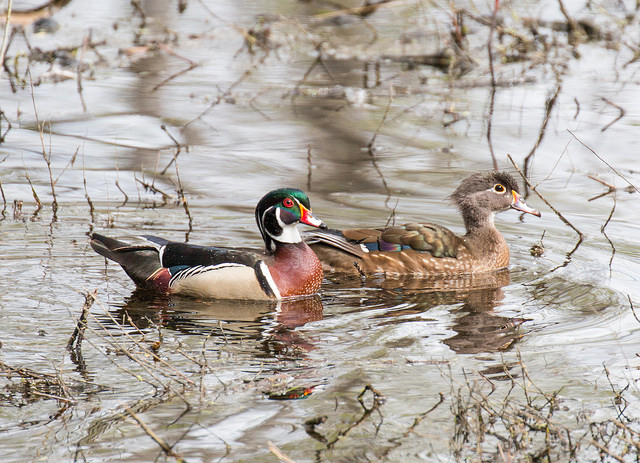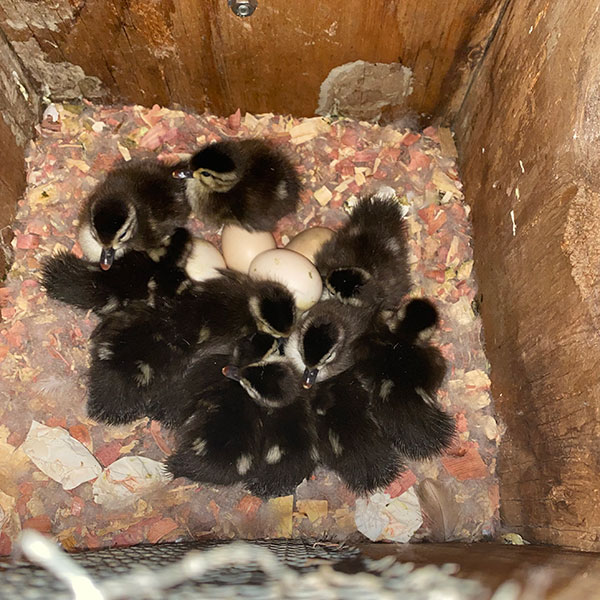Wood Duck Nest Box Report 2023
The Biology team here at Cache Creek Nature Preserve submitted their 2023 Wood Duck Nest Box Report recently. This post provides some general information about Wood Ducks and some highlights and raw data for students and citizen scientists to consider. Scroll down to download the original reports for 2023 and 2022.
General Information about Wood Ducks
Wood Ducks (Aix sponsa) are unusual waterfowl in that they perch and nest in trees. They have claw-like nails in their webbed feet to help them with that.

The males are distinctively colorful with their green, iridescent heads and precise orange, black and white markings. The females are brown with white trim and have a white eye patch.
Learn their sounds on the Audubon page.
They have no close relatives except for the Mandarin Duck of eastern Asia.
They are not capable of making their own nesting cavities, so they use rotted tree trunks, broken off branches or old woodpecker holes. And they love a good nest box! Especially since the demand for natural cavities is increasingly higher than what is actually available due to forest loss, fire, drought, and floods.
Nest boxes need to be located along streams and other open bodies of water that provide 50-75% vegetative cover. The coverage helps them feel safe, hide them from predators, and helps regulate cavity temperature. Nest boxes need to be close to water so the mother travels less distance to lead her ducklings into the water (where they are safer). Wood Ducks forage on mostly aquatic foods consisting of seeds, fruits, and insects, but can also take to dry land to forage if needed.
Wood Ducks are a “precocial” species, meaning their young are quite well-developed when they are born, and only remain in the nest for about 24 hours before leaving with their mothers.
The field team got a lucky glance at ducklings inside box 4 on May 1st, 2023.

After the first clutch are raised up and on their own, Wood Ducks will raise another batch if the season allows. This is called ‘re-nesting’.
Wood Duck numbers declined drastically in the late 1800s, but conservancy laws and nest boxes brought them back. An “…early triumph of wildlife management.” according to Audubon’s Wood Duck page.
Nest Box Monitoring Methods
The Cache Creek Conservancy cares for and monitors various typse of nest boxes at the Nature Preserve (CCNP), Capay Open Space Park (COSP) and the Granite-Woodland Reiff (GWR). This report is focussed on the 17 nest boxes made for Wood Ducks at the CCNP. Our Wood Duck boxes are almost twice as tall, wide and long as the songbird boxes, with larger holes. The holes just big enough for the ducks to enter but not too large to allow other unwelcome visitors (like raccoons). Our Wood Duck box entrances are about 3 in high and 4 in wide.
Wood Duck breeding season is from early March to late-August. CCC staff, interns and volunteers, led by Felicia Wang, Restoration Biologist, followed best practices for monitoring for 24 weeks. They cleaned and repaired the boxes in February, before the season started.
During the 2023 breeding season, the nest boxes were carefully approached by the field team. Before opening, a camera was inserted through the box entrance to obtain a view of any hens or eggs within. If a Wood Duck hen was present inside, the box check would be skipped for the week to prevent stressing the hen. The hen’s presence would be recorded and no data would be collected. If no hen was inside, the box check would proceed and data would be collected. Afterwards, the eggs would be covered again in downy feathers and wood shavings to keep them warm. The box check was kept to five minutes or shorter in order to reduce disturbance to the nest and any nearby Wood Ducks.
What data was collected?
- hen’s status (present or absent)
- number of eggs (whole, hatched, and missing or depredated)
- box status:
- nest was normal
- showed no activity
- abandoned
- hatched
- number of dead ducklings
- presence of feathers
- relative temperature of eggs (warm or cold)
- parasites
- any other notable observations
Definitions
Precocial
From the Oxford dictionary online.
(of a young bird or other animal) hatched or born in an advanced state and able to feed itself and move independently almost immediately.
(of a particular species) having precocial young.
Depredation
From dictionary . com.
the act of preying upon or plundering; robbery; ravage.
(notice the word ‘predation’ within the word.)
Since Wood Ducks are precocial, the team rarely saw ducklings in the nests. This means that counting the number of fledged ducklings was determined by the number of normally hatched eggs minus dead ducklings left behind.
Eggs that failed to hatch
Under certain conditions, eggs that failed to hatch were removed and placed far away from the box for scavenger or opportunistic wildlife to consume. The team only did this when the rest of the clutch was already hatched and had gone off with their mother, or when the eggs were cold and no hen was observed on them for three consecutive weeks. Some eggs were opened to observe the stage of embryo development.
Dead ducklings were either placed far from the nests or taken to UC Davis Museum of Wildlife and Fish Biology for research.
Summary of Results
Here are a couple of tables of data points, rates, and totals resulting from the team’s observations.
| Nesting Attempts | 2023 | 2022 |
|---|---|---|
| Number of nest boxes | 17 | 19 |
| Number of first nesting attempts | 14 | 9 |
| Occupancy rate | 82.53% | |
| Number of re-nesting attempts | 8 | 3 |
| Re-nesting rate | 57.14% | 33.33% |
| Total nesting attempts | 22 | 12 |
There were two less boxes monitored in 2023. One box got burned in a prescribed fire at the end of 2022 and one we did not monitor in 2023 because it was surrounded by poison oak!
| Breeding Success | 2023 | 2022 |
|---|---|---|
| Total number of eggs | 267 | 118 |
| Number of eggs hatched | 142 | 55 |
| Hatching success rate | 53.18% | 46.61% |
| Number of ducklings fledged | 141 | 47 |
| Fledging success rate | 99.30% | 85.45% |
Aspiring Biologists and Citizen Scientists
Based on this data, what conclusions would you draw about how Wood Ducks are doing at the Nature Preserve? What does this tell you about the Conservancy’s restoration efforts? Do you need more information to answer these questions? What kind of information and how would you get it if you were planning a field operation?
Take our poll and we’ll publish your conclusions anonymously in a month or so.
You should see a form in the green box below. If you don’t please feel free to Contact Us directly.
Conclusions and Recommendations
Even though there were two fewer boxes at the CCNP in 2023, breeding success doubled! While two points (two years) don’t make a trend, we are highly encouraged at this indication that the Preserve’s wetland and riparian habitats are great for Wood Ducks.
There were three boxes that were not used in 2022 or 2023. If this persists, they may need to be relocated. Along the creek or on the southwest side of the wetlands would be good locations since they are near water, there are fewer boxes and Wood Ducks have been spotted there.
Unruly Wildlife
It is interesting to note that one Wood Duck made its nest, and had a successful brood, in the Kestrel/Screech Owl nest overlooking the wetlands.
Then there was a European Starling (an invasive species) who kept building its nest on top of one of the Wood Duck nests. It took a couple weeks of removing the nest before she finally gave up and moved on. The Wood Duck abandoned her first clutch of eggs, but did return to successfully raise a brood of eight ducklings. Next time the team sees this kind of thing, they plan to visit the nest more often to discourage the interloper more quickly.
It is worth noting that invasive and non-native birds are not protected under the Migratory Bird Act, which allows us to remove the starling nest.
Download 2023 Wood Duck Nest Box Monitoring Report (PDF)
Download 2022 Wood Duck Nestbox Monitoring Report (PDF)
At the time of this writing, February 2024, one can see Wood Ducks on top of the next boxes. It’s as if they are ‘apartment hunting’, checking out the best spots to start a family for the upcoming season.
In the News
Wood ducks doing well at Cache Creek Nature Preserve
Daily Democrat, January 17, 2024 by Jim Smith
